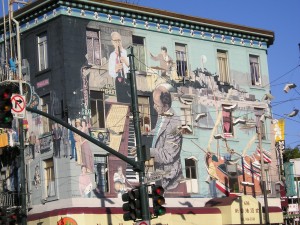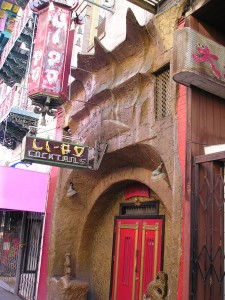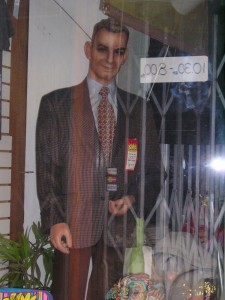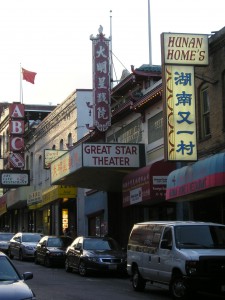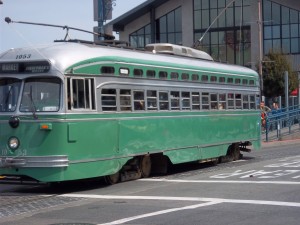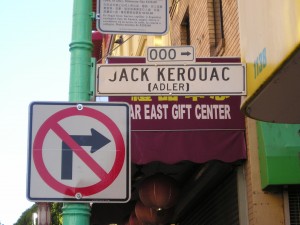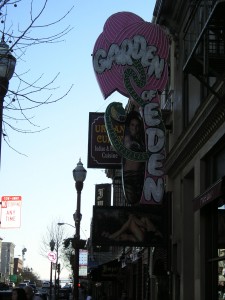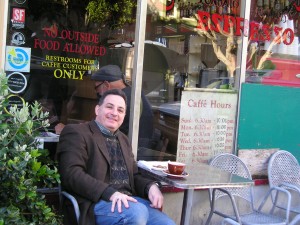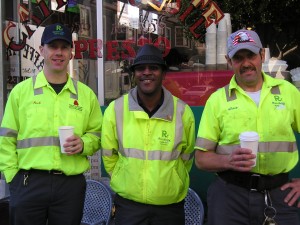As I mentioned in my first blog post on visiting San Francisco, I think one of the greatest pleasures the modern world offers is the opportunity to visit a great city for the first time and to see it with virgin eyes. If one has the chance to wander somewhat aimlessly and drink in the sights of a new city at one’s leisure, one should grab that chance.
I didn’t have a tremendous amount of leisure time during my business trip to San Francisco, but I did my best to make the most of the time I had. After my Tuesday at the office supporting computer training, I headed back to my hotel, changed my clothes, rested a short while, and then headed through Chinatown on my way to hop aboard a Hyde Street cable car.
I loved Chinatown. I loved the ticky-tacky street vistas of Chinatown, with the chains of red lanterns strung from storefront to storefront across the narrow roadways. I loved seeing neon signs in both Mandarin Chinese and English. I loved this creepy cocktail lounge, made to look like the entrance to a cave… a dragon’s lair. Oddly enough, I was in the middle of reading a collection of Agents of Atlas comics, which is partially set in a subterranean city hidden half a mile beneath San Francisco, guarded by a dragon, and the surface entrance to the city is accessed through… a creepy cocktail lounge in Chinatown.
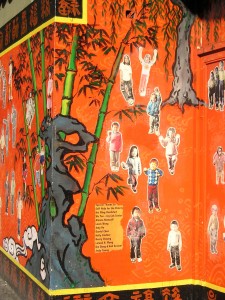
Mural on front of Chinatown Head Start, thanking the children for being helpful to their elders at a senior citizens' center
I stopped to look at the cut-out photos of children adorning a mural on the front wall of a Chinatown Head Start center. An inscription near the bottom of the mural thanked the center’s children for being especially helpful to their elders at a nearby senior citizen’s center. I liked that; it wasn’t something I was likely to run into back in Manassas. Half a block away, elderly men and women practiced their tai chi in the early morning in a park I could view from the nineteenth floor of my hotel, a park where children, maybe those same children from the Head Start center, played on slides and climbing bars. It was refreshing to see such disparate generations freely intermingling. A porter at my hotel told me the elderly are out there in the park doing their tai chi every single morning, no matter the weather.
Shopping was fun. One store I wandered into was a typical teeshirts-and-souvenirs joint in the front and a men’s clothing store in the back. The men’s clothing portion was only open on Wednesdays. I made a note to come back the following day, Wednesday, so I could shop for a sport coat. For sitting in the display window was a mannequin straight out of the Lincoln Road of my Miami Beach youth, mid-1960s vintage, wearing a checkered sport coat I would kill for. Plus, the mannequin had a rather endearing look on his face – a look of mischievous embarrassment, as though he’d just farted on an elevator. Oh, how I wanted his coat! Which was on sale! For $78.95! But, alas, when I returned to the shop the next day to speak with the proprietor, I discovered that he only stocked jackets and suits in short sizes. I wear a regular, so I was out of luck.
A Hyde Street cable car waited for me at the edge of Chinatown. Some sort of accident a block north had kept the cable car and two behind it sitting immobile for fifteen minutes or so. The car I boarded was crowded with a group of tourists from France. One of the French women was quite incensed that the cable car would not move. She berated the operator and demanded that she and her entire party receive a refund of their fares (six bucks a head, not an inconsiderable sum), saying they would be late for their dinner engagement. One does not board a cable car, I believe, if one is in a hurry; one flags down a cab. The operator said he could not refund her money, at which point she continued to berate him, at which point he exited the cable car to go talk with the operator of the car stalled to our rear.
After I had sat on the cable car for about ten minutes (not in any hurry to get anywhere myself, enjoying being able to absorb the details of the surrounding neighborhood), the accident ahead was cleared, and the cable car began to move. What a shambling, clanking, vibrating, crashing, wonderful mechanical monstrosity! By way of comparison, the electric streetcars I remember riding in New Orleans were paragons of smoothness and quiet. This beast, however, had the feel of an old-time roller coaster, a carnival ride of World War One vintage, albeit a roller coaster that operated in slow motion. I couldn’t hear the conversations of the French tourists, even though they were sitting only feet away from me. All I could hear was CLANK-CLANK-CLANK-CLANK-CLANK! During part of my ride, I sat next to the brake man, who operated three levers as long as his torso. His job was a physically exhausting one – he could hardly have worked harder had his task required him to jump out in front of the cable car on steep descents and lean his back against its prow with his heels dug into the pavement in order to slow it down. The way he leaned back with all his weight tugging on the levers, his gloved hands gripping the wooden handles so tightly that the veins on the backs of his hands must have bulged like blue wires, reminded me of the scenes of manual laborers continually adjusting the hands of gigantic clocks in the underground factory of Fritz Lang’s Metropolis. On the steepest part of the route, the part where we passed by Coit Tower, all the houses to my right and left looked weirdly askew, tilted at angles twenty or thirty degrees out of true, like buildings and rooms inside a fun house. This wasn’t public transportation – this was a thrill ride, one that just happened to wind through other people’s very pricey neighborhoods. I could just hear my boys shouting (had I brought them along), “Again! Again! Let’s ride it AGAIN!”
I’d told myself I would ride to the end, get off, walk around whichever neighborhood the car let me off in, then get back on and ride back to the Financial District. My ride ended at the edge of the Fisherman’s Wharf area. The weather was whip-windy and cool, on the verge of cold. I hadn’t dressed especially warmly, wearing a light sweater and a sport coat, but I figured I’d stay adequately warm if I walked briskly enough. The lateness of the hour on a Tuesday evening and the biting wind combined to keep most pedestrians inside, in one of the seafood restaurants or hotels that lined the waterfront. One of the only persons I passed on the sidewalk was a man who had dressed his three dogs like clowns and asked me to pay him to have my photo taken with them. (I didn’t oblige him.)
Then I heard an odd sound echoing down the empty waterfront street. A kind of barking – but not that of dogs – and honking – but not that of car horns. I followed the noise, remembering that I’d read somewhere that a colony of sea lions had taken up residence somewhere on the San Francisco waterfront. Sure enough, when I came to the end of a deserted wharf, I found them, even though they blended completely into the darkness (the moon was almost full, so I was able to just barely see the silhouettes of the sea lions when they slid over one another and scootched themselves about). The clamor they were capable of making was terrific — imagine a “free jazz” concert of dozens and dozens of tenor and bass saxophones, French horns, tubas, and trombones, mixed in with raucous belches, bleetings, honkings, snarls, sneezes, bleatings, and lots and lots of panting and slapping of wet flippers against wet hides. Knowing my wife Dara was a big-time animal-lover, even though it was midnight back in Virginia, I called her up on my cell phone. “Sorry to wake you, hon, but I knew you’d want to hear this!” And I held my phone out over the water.
She wasn’t angry with me. That’s how marvelously unearthly, weird, and wonderful those hundred or so sea lions sounded in the darkness.
On my walk back to the cable car line (after listening to the sea lions for three-quarters of an hour), I came across one of the other gems of the city’s historic public transportation system. San Francisco has collected dozens and dozens of vintage electric streetcars from transit systems all over the nation and all around the world. I followed one car for several blocks which had spent the first few decades of its life in Chicago. Here’s a terrific site which gives histories and details for all of the historic streetcars which have been restored by San Francisco’s Municipal Railway system and which run through historic San Francisco neighborhoods every day. Here’s a page giving all the details on the Chicago-sourced streetcar I followed for a few blocks in the Fisherman’s Wharf neighborhood. The entire San Francisco mass transit system can be thought of as a living, working museum. For those of a nostalgic bent or for fans of street railways, it’s worth a visit all on its own.
After I returned to the Financial District, a little after 10 PM, I spent an hour or so wandering around North Beach, the historically Italian neighborhood right next to Chinatown. There’s a little alley a block long that runs between City Lights Books and Café Vesuvio and that connects the edge of North Beach with the edge of Chinatown. Formerly named Adler, it has been renamed Jack Kerouac Lane. If one approaches it from the Chinatown side, one is confronted with a big No Right Turns sign just beneath Jack Kerouac’s name. In the last decade of his life, after he had published all of his major work, when he was living with his elderly mother in Florida and heading for an early death from cirrhosis of the liver, Kerouac vocally disapproved of many of his Beat compatriots’ embrace of the 1960s counterculture and the anti-war movement, seeing this as anti-American and against the love of country he had shown in writing On the Road, which he viewed as an ecstatic celebration of America. During one of their last meetings, Alan Ginsberg wrapped an American flag around Kerouac’s shoulders in an ironic gesture. It wouldn’t surprise me at all if one of Kerouac’s old friends in San Francisco arranged matters to have that No Right Turns sign installed beneath Jack’s name.
If you’re a fan of neon signage (as I am), North Beach has some of the most spectacular examples in San Francisco. Many of those examples, it turns out, are connected to strip joints. I wandered block after block of Broadway, attracted to glowing neon like a fluttering moth, only to find myself, as a solitary middle-aged man wandering the blue district at 11 PM, on the receiving end of the sales patter of every strip club barker in North Beach. One rather clever fellow fixated on the white collar of my shirt, saying his joint was running “white collar drink specials.” An hour earlier, when I’d been gritting my teeth against the wind near Fisherman’s Wharf, walking back to the cable car, a woman had mistaken me for a priest and asked me to pray for her.
I finished my evening stroll at City Lights Books, which remains open until midnight. I was their last customer. I browsed through a book of polemics on the state of jazz and picked up a copy of An Olaf Stapleton Reader, a collection of the great man’s essays, speeches, short fiction, and excerpts from his novels (published by one of my alma maters, Syracuse University Press). I debated taking the book next door to Café Vesuvio and seeing if they still had any coffee brewing, but I decided I was too tired (and I knew I had to get up early to support computer training the next morning). Even the most wonderful evenings out must eventually come to an end.
My last morning in San Francisco, I woke up early to make sure I’d have time to have a leisurely coffee and light breakfast at Caffe Trieste, one of the older coffeehouses I’d seen during my nighttime wanderings through North Beach. Caffe Trieste’s North Beach location was established in 1956, and it claims to be the oldest espresso-serving coffeehouse on the West Coast. I didn’t order an espresso, but their cappuccino was first-rate, at least as good as any I’ve had in New Orleans or New York. I sat outside at one of the four small tables in front of the café’s windows and asked one of the three gentlemen sitting next to me to take my picture. Turned out the three fellows were all sanitation workers who work a route that includes North Beach, and they stop at Caffe Trieste most mornings. Great guys with great stories about maneuvering their sanitation truck through San Francisco’s tight, steep, winding streets. They don’t have an easy job, but they seem to like it well enough; one of them, Dave, has been doing it for almost twenty-five years, and the three of them know all the local characters in North Beach.
Here’s a short list of food and coffee spots in North Beach, Chinatown, and the Financial District which I patronized and can highly recommend.
Enjoy Vegetarian Restaurant
839 Kearney Street, San Francisco
(415) 956-7868
(This unassuming little restaurant was only a block from my hotel and featured a gigantic vegetarian Chinese menu. I loved the food there so much that, after my dinner there on Monday night, I ate lunch there on Tuesday and Wednesday.)
Tricolore Caffe
590 Washington Street, San Francisco
(415) 391-0509
(Located across the street from the Transamerica Pyramid, this little café is a great breakfast and lunch spot. Their coffee is very good and very inexpensive, with free refills, and their pastries are out-of-this-world good. Michael, the owner, moved to San Francisco from Italy as a teenager. Like me, he is a big fan of Italian writer Primo Levi.)
Caffe Trieste—North Beach
601 Vallejo Street, San Francisco
(415) 392-6739

